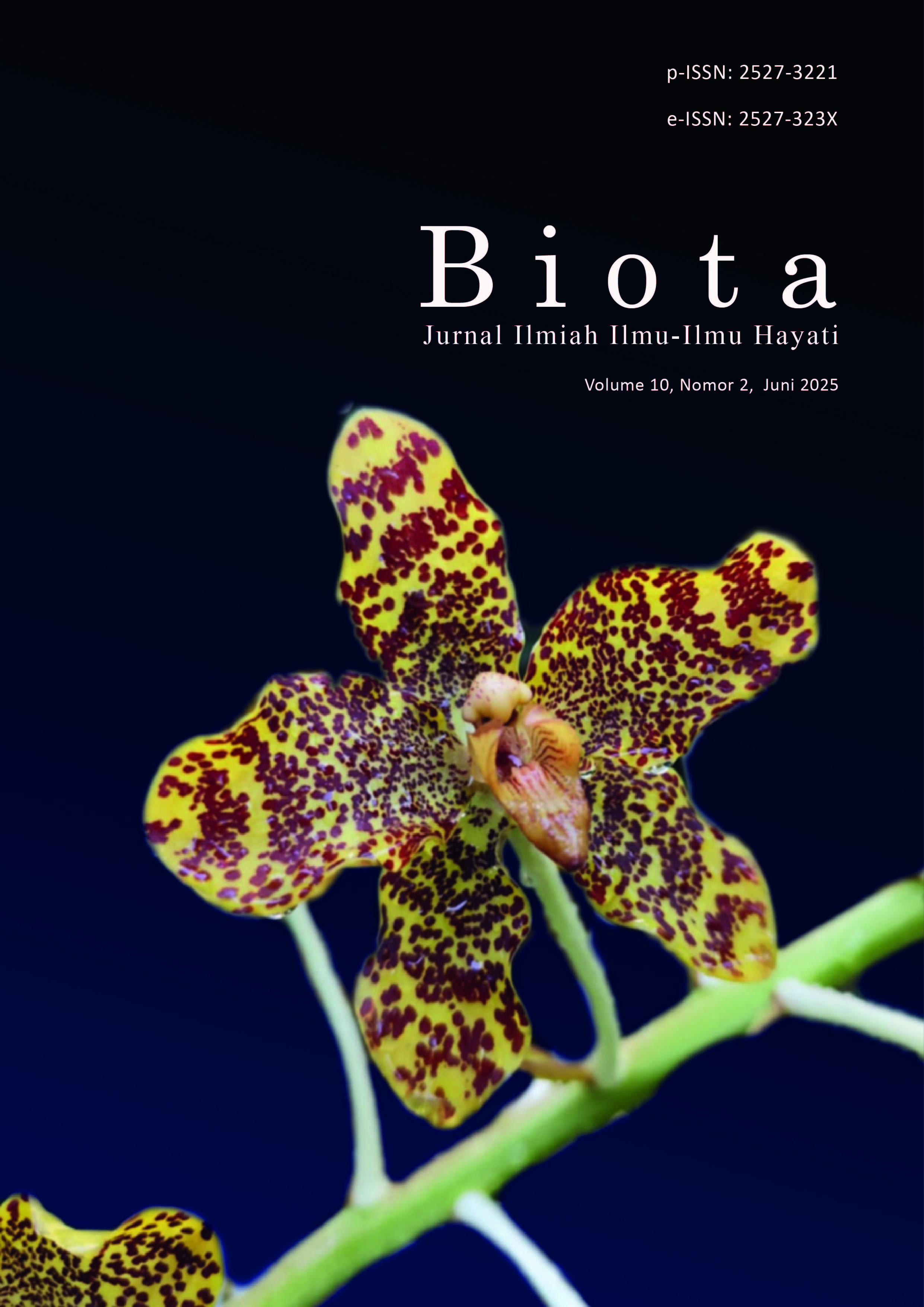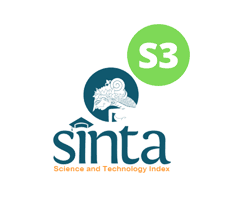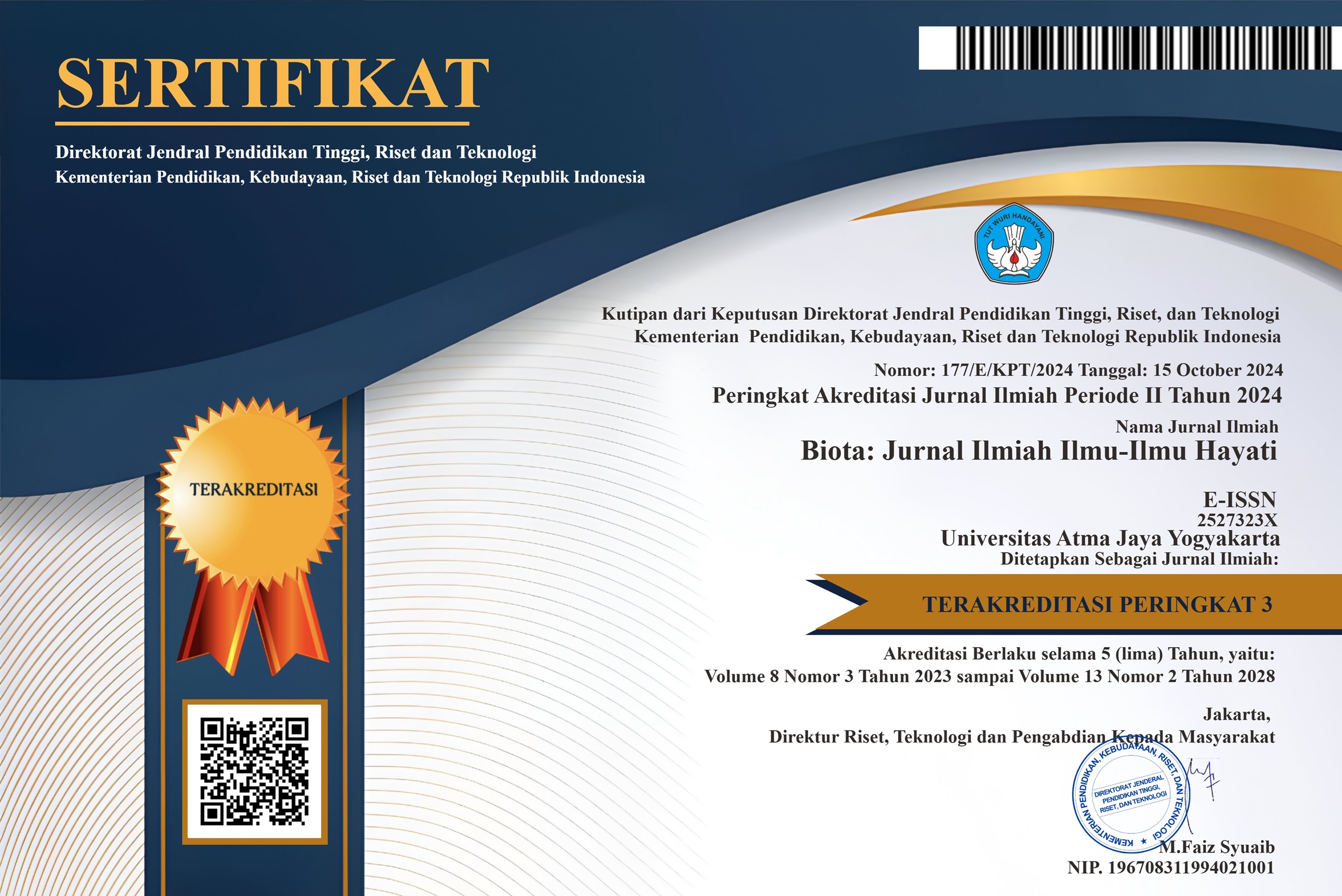Pharmacological Benefits of Porang (Amorphophallus muelleri Blume): A Review
DOI:
https://doi.org/10.24002/biota.v10i2.10308Keywords:
Amorphophallus muelleri Blume, glucomannan, benefits, healthAbstract
Porang (Amorphophallus muelleri Blume) is a tuber plant from the Araceae family that grows wild in Indonesian forests. Porang tubers have a high content of the active compound glucomannan, a low-calorie hydrocolloid dietary fiber with various health benefits. However, its potential in the pharmaceutical field has not been fully explored scientifically, so this scientific review aims to explore the potential of glucomannan and other bioactive compounds in porang in the pharmaceutical field based on literature studies, as well as the challenges of developing it as a leading commodity in Indonesia. In addition to glucomannan, porang also contains secondary metabolites such as alkaloid, flavonoids, saponins, tannins, and steroids. Research studies show that porang can be used in the treatment of various diseases, such as diabetes (especially type-2 diabetes mellitus), obesity, hypertension, and has the potential as anti-cholesterol, anti-tumor, anti-inflammatory, prebiotic agent, anti-bacterial, and wound healing. The majority of applications that are still in preclinical in vivo trials on experimental animals and the presence of calcium oxalate as an irritant compound are the challenges of developing Porang as herbal medicine. Therefore, the use of porang as herbal medicine still requires further research regarding safe processing and clinically appropriate dosage. Keywords: cacao fruit-rot, Phytophthora palmivora, biological control, decomposer.
References
Afifah, E., Nugrahani, M.O, & Setiono. (2014). Peluang budidaya iles-iles (Amorphophallus spp.) sebagai tanaman sela di perkebunan karet. Warta Perkaretan 33(1): 35-46.
Afifi, M. N., Harijati, N., & Mastuti, R. (2019). Anatomical characters of shoot apical meristem (SAM) on bulbil porang (Amorphophallus muelleri Blume) at the end of dormancy period. J. Exp. Life Sci. 9(1): 19–24.
Alrizzaqi, M.M., Putri, R.R.M., & Wardani, N.H. (2018). Implementasi metode dempster-shafer untuk mendiagnosis jenis tumor jinak pada manusia. Jurnal Pengembangan Teknologi Informasi dan Ilmu Komputer 2(5): 2144-2149.
Annisah, S. N. & Muhtadi. (2021). Uji Aktivitas Antioksidan Batang dan Daun Tanaman Porang (Amorphophallus muelleri Blume), Suweg (Amorphophallus paeoniifolius), Iles-Iles (Amorphophallus oncophyllus), dan Walur (Amorphophallus campanulatus) serta Profil Fitokimianya. Proceedings of the 13th University Research Colloqium (pp. 574–581). Klaten, Sekolah Tinggi Ilmu Kesehatan Muhammadiyah Klaten.
Apu, I. R., Jawang, U. P. & Nganji, M. U. (2022). Analysis of land suitability for the development of porang (Amarphopallus oncophillus) plants in Lewa Sub-Regency, East Sumba Regency. J. Tanah dan Sumberdaya Lahan 9(1): 49–55.
Ardhian, D. & Indriyani, D.S. (2013). Kandungan oksalat umbi porang (Amorphophallus muelleri Blume) hasil penanaman dengan perlakuan pupuk P dan K. J. Biotropika 1(2): 53–56.
Ashan, M. A., Bahrun, A. H., Reflinur & Ashan, M. D. (2023). Amorphophallus muelleri Blume diversity based on morphological characteristics in South Sulawesi. IOP Conf. Ser. Earth Environ. Sci. 1230(1): 1-7.
Behera, S. S. & Ray, R. C. (2016). Konjac glucomannan, a promising polysaccharide of Amorphophallus konjac K. Koch in health care. Int. J. Biol. Macromol. 92: 942–956.
Bozomitu, L., Miron, I., Adam, R.A., Lupu, A., Paduraru, G., Marcu, F.M.; Buga, A.M.L., Rusu, D.C., Dragan, F., Lupu, V.V. (2022). The gut microbiome and its implication in the mucosal digestive disorders, Biomedicines, 10(12): 1–18.
Chairiyah, N., Harijati, N. & Mastuti, R. (2013). Variation of calcium oxalate (CaOx) crystals in porang (Amorphophallus muelleri Blume), Am. J. Plant Sci. 4(9): 1765–1773.
Chen, B., Xu, X., Zheng, K., Liu, L., Yu, Y., & Xin, Y. (2020). Konjac glucomannan reverses multi.drug resistance of HepG2/5-FU cells by suppressing AKT signaling and increasing p53 expression. Oncol. Lett. 20(3): 2105–2112.
Chen, H., Nie, Q., Hu, J., Huang, X., Zhang, K., & Nie, S. (2019). Glucomannans alleviated the progression of diabetic kidney disease by improving kidney metabolic disturbance. Mol. Nutr. Food Res. 63(12): 1–22.
Chen, X., Yuan, L. Q., Li, L. J., Lv, Y., Chen, P. F., & Pan, L. (2017). Suppression of gastric cancer by extract from the tuber of amorphophallus konjac via induction of apoptosis and autophagy. Oncol. Rep. 38(2): 1051–1058.
Chua, M., Baldwin, T. C., Hocking, T. J., & Chan, K. (2010). Traditional uses and potential health benefits of amorphophallus konjac K. Koch ex N.E.Br. J. Ethnopharmacol. 128(2): 268–278.
Ekowati, G., Yanuadi, B., & Azraningsih, R. (2015). Sumber glukomanan dari edible araceae di Jawa Timur. J. Pembang.dan Alam Lestari 6(1): 32–41.
Erikania, S. & Rosalina,V. (2023). The potential leaves of porang (Amorphophallus muelleri Blume) as antioxidant and antibacterial Escherichia coli and Salmonella typhi. Jurnal Biologi Tropis 22(1): 382-387.
Endang, P.R., Joni, I.M., Ikhwan, W., & Muhammad, A. (2022). Cultivation potential of porang (Amorphophallus muelleri Blume) in Central Indonesia, RJOAS 12(132): 157–165.
Fang, Y., Ma, J., Lei, P., Wang, L., Qu, J., Zhao, J., Liu, F., Yan, X., Wu,W., Jin, L., Ji, H., & Sun, D. (2023). Konjac glucomannan: an emerging specialty medical food to aid in the treatment of type 2 diabetes mellitus, Foods 12(2): 2-17.
Fatchiyah, F., Nurmasari, D. A., Masruro, N., Rohmah, R. N., Triprisila, L.F., Mulyati, M., Yamada, T., & Ohta, T. (2019). Level of mRNA insulin gene and blood glucose STZ-induced diabetic rat are improved by glucomannan of Amorphophallus muelleri Blume from East Java Forest Indonesia. J. Trop. Life Sci. 9(2): 163–169.
Febrianti, R., Gunardi, D. W., Trio, S., & Hari, K. (2023). Pengelolaan tumbuhan porang untuk kesejahteraan masyarakat di Desa Tegal Yoso. JOFPE Journal 3(2): 32-39.
Feng, Y., Li, X., Zhang, Q., Yan, S., Guo, Y., Li, M., & You, R. (2019). Mechanically robust and f lexible silk protein/polysaccharide composite sponges for wound dressing. Carbohydrate Polymers 216: 17–24.
Fountain, J. H., Kaur, J., & Lappin, S. L. (2023). Physiology, Renin Angiotensin System. In StatPearls. Treasure Island: StatPearls Publishing.
Franceschi, V. R. & Nakata, P. A. (2005). Calcium oxalate in plants: Formation and function, Annu. Rev. Plant Biol. 56: 41–71.
Gao F., Zhang W., Cao M., Liu X., Han T., He W., Shi B., & Gu Z. (2024). Maternal supplementation with konjac glucomannan improves maternal microbiota for healthier offspring during lactation. J. Sci. Food Agric. 104(60): 3736–3748.
Gusmalawati, D., Arumingtyas, E. L., Azrianingsih, R., & Mastuti, R. (2019). LC-MS analysis of carbohydrate components in Porang tubers (Amorphophallus muelleri Blume) from the second and the third growth period. IOP Conf. Ser. Earth Environ. Sci. 391(1): 1-7.
Gusmalawati, D., Arumingtyas, E. L., Mastuti, R., & Azrianingsih, R. (2021). Determination of postharvest quality of porang (Amorphophallus muelleri Blume) tubers based on the dynamics of weight loss, water content and carbohydrate components for the pharmaceutical industry. Farmacia 69(6): 1145–1152.
Gusmalawati, D., Azrianingsih, R., Wibowo, MA., Tribudi, YA., Rousdy, DW., Wahyudi, D., Agustin, AT, & Widodo, N. (2024). An Insight on potential role of glucomannan, mannan, and flavonoids in porang tubers (Amorphophallus muelleri Blume) as anti-diabetic through the alpha-amylase inhibition. Jordan J. Biol. Sci. 17(2): 293–299.
Gusmalawati, D., Indriyani, S., Azrianingsih, R., & Abidin, Z. (2023). Struktur dan perkecambahan serbuk sari pada porang (Amorphophallus muelleri Blume). G-Tech: Jurnal Teknologi Terapan 7(2): 752–761.
Gusmalawati, D., S. Indriyani, & Azrianingsih, R. (2013). Anatomy and histochemistry of generative organ of Amorphophallus muelleri. Floribunda 4(7): 175–181.
Hanifah U., Novrinaldi, Haryanto A., Furqon M., Ma`muri, & Mulyani D. (2024). Manufacture and performance test of suspended batch centrifuge for extraction of glucomannan from porang (Amorphophallus muelleri Blume). IOP Conf. Ser. Earth Environ. Sci. 1377(1): 1-11.
Harbuwono, D.S., Laurentius, A., Pramono, Yunir, E., & Subekti, I. (2018). Obesity and central obesity in Indonesia: evidence from a national health survey. Medical Journal of Indonesia 27(2): 114-120.
Hayeeawaema, F., Wichienchot, S., & Khuituan, P. (2020). Amelioration of gut dysbiosis and gastrointestinal motility by konjac oligo-glucomannan on loperamide-induced constipation in mice. Nutrition, 73: 110715.
Hidayat, R., Dewanti, F. D., & Guniarti, G. (2020). Kajian konsentrasi sitokinin dan dosis pupuk NPK terhadap pertumbuhan dan hasil bulbil tanaman porang (Amorphophallus onchophyllus Blume). Berkala Ilmiah Agroteknologi: Plumula 7(1): 33–44.
Hosiana, A., Pinatih, GNI., & Laksemi, DAAS. (2023). Beneficial health effects of porang (Amorphophallus muelleri): A review. Indones. J. Biomed. Sci. 17(2): 235–238.
Ibrahim, M.S.D. (2019). Conventional Propogation and in vitro culture of Iles-Iles (Amorphophallus spp.) and its development strategy. Perspektif 18(1): 67-78.
Idoko A., Ugwudike, P.O., Ayomide, T.A., & Blessing, N.O. (2020). Cholesterol and its implications- a review. Universal Journal of Pharmaceutical Research 5(6): 52-63.
Illahi, A. K., Kurniasih, D., Sari, D. A., & Karmaita, Y. (2022). Karakterisasi morfologi pada bibit porang (Amorphophallus oncophyllus). Lumbung 21(1): 14–23.
Indonesian Porang Research and Development Center. (2019). Budidaya dan pengembangan porang (Amorphophallus muelleri Blume) sebagai salah satu potensi bahan baku lokal, in Modul Diseminasi.Brawijaya University. Malang
Isnaini, H., Kautsarani, I., & Fikri, S. (2023). Exploring the potential of porang (Amorphophallus muelleri B.) as horticultural plants in Bocok Hamlet, Pondokagung Village, Kasembon District, Malang Regency, East Java. Genbinesia 3(1): 1–5.
Kaczmarek-Szczepańska, B., Zasada, L., D’Amora, U., Pałubicka, A., Michno, A., Ronowska, A., & Wekwejt, M. (2024). Bioactivation of konjac glucomannan films by tannic acid and gluconolactone addition, ACS Appl. Mater. Interfaces 16(35): 46102–46112.
Kang, Y., Ren, P., Shen, X., Kuang, X., Yang, X., Liu, H., Yan, H., Yang, H., Kang, X., Ding, Z., Luo, X., Ma, J., Yang, Y., & Fan, W. (2023). A newly synbiotic combination alleviates obesity by modulating the gut microbiota–fat axis and inhibiting the hepatic TLR4/NF-κB signaling pathway. Mol. Nutr. Food Res. 67(24).
Kang, Y., Li, Y., Du, Y., Guo, L., Chen, M., Huang, X., Yang, F., Hong, J., & Kong, X. (2018). Konjaku flour reduces obesity in mice by modulating the composition of the gut microbiota. Int. J. Obes. 43(8): 1631–1643.
Koswara, S. (2013). Modul Teknologi Pengolahan Umbi-Umbian. SEAFAST Center. Bogor Agricultural University. Bogor
Lawrie, N.S., Cuetos, N.M., Sini, F., Salam, G.A., Ding, Vancolen, A., Nelson, J.M. Erkens, R.H.J., & Pervensi, G. (2023). Systematic review on raphide morphotype calcium oxalate crystals in angiosperms. AoB Plants 15(4): 1–16.
Li, J. Y., Sun, F., Zhou, H.F., Yang, J., Huang, C., & Fan, H. (2019). A systematic review exploring the anticancer activity and mechanisms of glucomannan. Front. Pharmacol. 10: 1–9.
Liu, R., Li, Y., & Zhang, B. (2016). The effects of konjac oligosaccharide on TNBS-induced colitis in rats. Int. Immunopharmacol 40: 385–391.
Luo W, Liu F, Qi X, Dong G. (2022). Research progress of konjac dietary fibre in the prevention and treatment of diabetes. Food Sci. Technol. 42.
Masniawati, A., Eva, J., Magfira., & Mustika, T. (2023). Analisis glukomanan umbi porang (Amorphophallus muelleri Blume) dari beberapa daerah di Sulawesi Selatan. Jurnal Ilmu Alam dan Lingkungan 14(2): 1–10.
Mutmaidah, S., & Rozi, F. (2015). Peluang Peningkatan Pendapatan Masyarakat Tepi Hutan Melalui Usahatani Porang. Prosiding Seminar Hasil Penelitian Tanaman Aneka Kacang dan Umbi 2015 (hal. 709–716). Malang: Balai Penelitian Tanaman Aneka Kacang dan Umbi.
Naufali, MN., & Destiana, AP. (2023). Potensi pengembangan porang sebagai sumber bahan pangan di Pulau Lombok Nusa Tenggara Barat. Biofoodtech 1(2): 65–75.
Nugraheni, B., Cahyani, I. M., & Herlyanti, K. (2014). Efek pemberian glukomanan umbi porang (Amorphophallus oncophyllus) terhadap kadar kolesterol total darah tikus yang diberi diet tinggi lemak. J. Ilmu Farm. dan Farm. Klin. 11(2): 32-36.
Ojo, O.A., Ibrahim, H.S, Rotimi, E., & Ogunlakin, D. (2023). Diabetes mellitus: From molecular mechanism to pathophysiology and pharmacology. Medicine in Novel Technology and Devices 19:1-8.
Patel, J. (2008). Diabetes: Managing dyslipidaemia. BMJ Clin. Evid. 6(610): 1-27.
Putra, B. A., Mashudi, S., Sari, A. P., Afriani, F. R., Aziz, Y. S., & Tukimin, T. (2024). Positive effect of konjac glucomannan on lowering blood pressure in hypertensive wistar rats. Qanun Med.: Med. J. Fac. Med. Muhammadiyah Surabaya 8(2): 339-348.
Rahayuningsih, Y. (2020). Strategi pengembangan porang (Amorphophalus muelleri) di Provinsi Banten. Jurnal Kebijakan Pembangunan Daerah 4(2): 77–92.
Rahman, M.S., Hossain, K.S., Das, S., Kundu, S., Adegoke, E.O., Rahman, M.A., Hannan, M.A., Uddin, M.J. & Pang, M.-G. (2021). Role of insulin in health and disease: an update. Int. J. Mol. Sci., 22(12): 6403.
Rahman, S.N., Santos, H.A.D., & Jaya, A.M. (2024). The diferences cholesterol level of employees with nutritional status overweight and non overweight. Jurnal Ilmu Keolahragaan 7(2): 334-343.
Saleh, N., Rahayuningsih S.A., Radjit B.S., Ginting, E., Harnowo, D., & Mejaya, I.M.J. (2015). Tanaman Porang: Pengenalan, Budidaya, dan Pemanfaatannya. Food Crops Research and Development Center, Agricultural Research and Development Agency: Bogor.
Sahputra R. (2023). Analisis kandungan natrium (Na) pada tanaman porang (Amorphophallus oncophyllus). Quantum 3(1): 1–8.
Santosa, E., Lontoh, A., Kurniawati, A., Sari, M., & Sugiyama N. (2016). Flower development and its implication for seed production on Amorphophallus muelleri Blume (Araceae). J. Hortik. Indones. 7(2): 65–74.
Siswanto, B. & Karamina, H. (2016). Persyaratan lahan tanaman porang (Amarphopallus oncophillus). Buana Sains 16(1): 57–70.
Sumarwoto. (2005). Iles-iles (Amorphophallus muelleri Blume): description and other characteristics, Biodiversitas J. Biol. Divers. 6(3): 185–190
Suryani, N.P.F., Hita, I.P.G.A.P., & Septiari, I.G.A.A. (2023). Skrining fitokimia dan uji aktivitas antioksidan ekstrak daun porang (Amorphophallus muelleri B.) dengan pelarut ekstraksi etanol, etil asetat, dan n-Heksana. Journal Scientific of Mandalika (JSM) 4(9): 179–194.
Susanti, N. (2014). Suplementasi tepung porang (Amorphophallus muelleri Blume) sebagai nutraceutical dalam manajemen diabetes mellitus tipe 2. El-Hayah 5(1): 9-16.
Sutriningsih, A., & Ariani, N.L. (2017). Efektivitas umbi porang (Amorphophallus oncophillius) terhadap penurunan kadar glukosa darah penderita diabetes mellitus. Care J. Ilmiah Ilmu Kesehatan, 5(1): 48–58.
Tahar, N., Wahyuni, D., Adawiyah, R., Khaerani, & Wahyuddin, M. (2023). Formulation and antibacterial activity of porang (Amorphophallus muelleri Blume) Extract gel against propionibacterium acne. Ad-Dawaa’ J. Pharm. Sci. 6(1): 83–92.
Udarno, L. (2020). Porang (Amorphophallus muelleri) dan Cara Budidaya. Warta Penelitian dan Pengembangan Tanaman Industri, 26(1): 1–6.
Utami, N.M.A.W. (2021). Economic prospects of porang plant development in the pandemic time Covid-19. J. Ilmiah Ilmu-Ilmu Pertanian 15(1): 72–82.
Wang, C., Li, B., Chen, T., Mei, N., Wang, X., & Tang, S. (2020). Preparation and bioactivity of acetylated konjac glucomannan fibrous membrane and its application for wound dressing. Carbohydrate Polymers 229: 115404.
Wardani, R.K., & Handrianto, P. (2019). Reduksi Kalsium Oksalat pada Umbi Porang dengan Larutan asam. Graniti: Gresik
Wulan, D.I., Setiawan, A.A., & Laksmitawati, D. (2021). Macronutrients analysis of porang tubers (Amorphophallus muelleri Blume) fermentation with lactobacillus bulgaricus bacteria. Advances in Health Sciences Research 33(1): 488–492.
Yuzammi, Witono, J.R, & Hetterscheid, W. L. (2014). Conservation status of Amorphophallus discophorus Backer & Alderw. (Araceae) in Java, Indonesia. Reinwardtia 14(1): 27–33.
Zhao, J., Zhang, D., Srzednicki, G., Kanlayanarat, S., Jianping, Z., & Borompichaichartkul, C. (2010). Morphological and growth characteristics of Amorphophallus muelleri Blume - A commercially important konjac species, Acta Hortic. 875: 501–508.
Zhao, Y., Jayachandran, M., & Xu, B. (2020). In vivo antioxidant and anti-inflammatory effects of soluble dietary fiber konjac glucomannan in type-2 diabetic rats, Int. J. Biol. Macromol. 159: 1186–1196.
Zheng, Q., Li, W., Liang, S., Zhang, H., Yang, H., Li, M., & Zhang, Y. (2019). Effects of ultrasonic treatment on the molecular weight and anti-inflammatory activity of oxidized konjac glucomannan. CYTA - J. Food 17(1): 1–10.
Zhou, Y., Jiang, R., Perkins, W.S., & Cheng, Y. (2018). Morphology evolution and gelation mechanism of alkali induced konjac glucomannan hydrogel. Food Chem. 269, 80–88.
Downloads
Published
How to Cite
Issue
Section
License
Copyright (c) 2025 Hanik Isnaini, Titan Memory Yuhana, Washeilatus Sholehah, Akyunul Jannah

This work is licensed under a Creative Commons Attribution-NonCommercial 4.0 International License.
Authors who publish with Biota : Jurnal Ilmiah Ilmu-Ilmu Hayati agree to the following terms:
- Authors retain copyright and grant the Biota : Jurnal Ilmiah Ilmu-Ilmu Hayati right of first publication. Licensed under a Creative Commons Attribution-NonCommercial 4.0 International License that allows others to share the work with an acknowledgment of the work's authorship and initial publication in this journal.
- Authors are able to enter into separate, additional contractual arrangements for the non-exclusive distribution of the journal's published version of the work (e.g., post it to an institutional repository or publish it in a book), with an acknowledgment of its initial publication in Biota : Jurnal Ilmiah Ilmu-Ilmu Hayati, and as long as Author is not used for commercial purposes.













